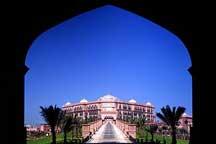 Jun. 28, 2025
Jun. 28, 2025
Weather
Feature: Tibetan houses in E Tibet's Dongba
2009-09-27 15:51 BJT
BEIJING, Sept. 17 (Xinhuanet) -- Dongba Township in eastern Tibet‘s Chamdo Prefecture, was once known as the "beggars‘ township." As Dongba is located in the valley of the Nujiang River, its natural conditions were harsh and transport services were poor.
However, since China initiated the reform and opening-up drive in the late 1970s, Dongba people have been seeking jobs outside the valley. After they return to their hometown, they will rebuild their houses. Now, a prosperous Dongba has taken on a new look.
The new Tibetan-style houses in Dongba are all built on the bases of old ones, with most of them being 20 to 30 meters high and having three storeys.

Photo shows the color paintings and engravings on a door of a house in Dongba Tonwship, eastern Tibet‘s Chamdo Prefecture. (Photo: tibet.cn)
The first floor is used for storage. On the second and third floors there are living rooms and bedrooms. The walls are about 1.2 meters thick to help keep off cold and heat. The windows of the houses are usually bigger than those in other parts of Tibet and that is why the houses there have better lighting and ventilation.
Phuntsok is a driver of a local school in Dongba. His family is an ordinary one and owns an orchard. Last year his family earned 14,000 yuan (2,051 U.S. dollars) from selling apples and 20,000 yuan (2,930 dollars) from selling other fruits.

Photo shows a corner of a living room of a house in Dongba Tonwship, eastern Tibet‘s Chamdo Prefecture. (Photo: tibet.cn)
The eight-room house was first built by his father and it has been about 10 years old. Later on, he and his two brothers repaired the house gradually and bought new furniture. Now the most beautiful room in the house is the scripture hall, with Buddhist sculptures and sutras inside.
Pema‘s house is above the average in his township. The new house was designed by himself and built with the help of his neighbors. The engraving and color paintings on the beams and windows were done by local craftsmen.

Pema smiles at his home in Dongba Township, eastern Tibet‘s Chamdo Prefecture. (Photo: tibet.cn)
Eleven members of the family live in 20 rooms. Pema said he did not spend a cent on building the house but 300,000 yuan (43,950 dollars) on building materials. He set up a construction team to hire jobless residents in the township.
In the fruit harvest time, he often drives his truck to transport and sell others‘ fruits, charging by each bag. Pema‘s family can make more than 100,000 yuan (14,650 dollars) a year, most of which will be spent in building or renovating their house.
Dongba people are keen on colors and the colors on the roofs and windows are meaningful. The most common ones are blue, red, green and yellow, symbolizing the sky, earth, rivers and religions.

Photo shows a kitchen of a house in Dongba Tonwship, eastern Tibet‘s Chamdo Prefecture. (Photo: tibet.cn)
The rich colors bring vitality and joy to the monotonous life in the township. Moreover, for those beautiful engraving or paintings, no matter which ethnic group they are from, the locals would like to adopt them and even create something new.
The patterns on some doors are the combination of the drawing and engraving from China‘s Sichuan and Yunnan provinces, India and Nepal. Some patterns, which stand for the rank and wealth and can only be used in monasteries, have also been used by the locals on their own houses. Some even make alters to them, and the act was praised as the "breakthrough in the construction of Tibetan houses" by some local humanists.
Speaking of why houses in Dongba are becoming larger and more luxury, Gasong Zepei, head of the township, said that the houses, on the one hand, represent the survival skills and wisdom of the people on the plateau; and that on the other hand, they showcase the affluence, and the economic and social status of a family.
At Dongba, said Gasong Zepei, houses do only meet the needs for dwelling, but also serve as a way of entrusting their spirits and benefiting Dongba people‘s decedents.
Editor: 卢佳颖 | Source: Xinhuanet
 Mail
Mail Share
Share Print
Print


 Video
Video









 2009 China Central Television. All Rights Reserved
2009 China Central Television. All Rights Reserved